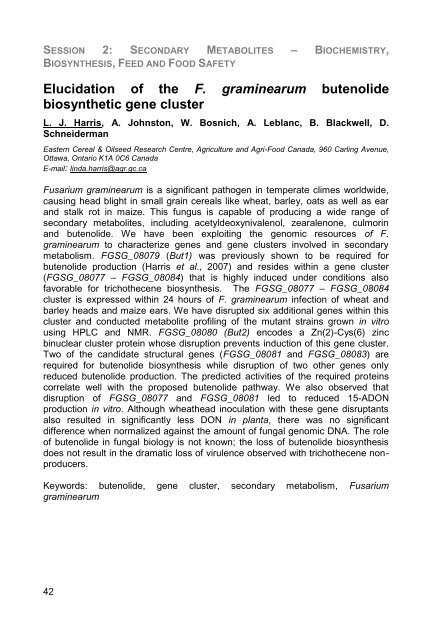EFS12- Book of abstracts - Contact
EFS12- Book of abstracts - Contact
EFS12- Book of abstracts - Contact
You also want an ePaper? Increase the reach of your titles
YUMPU automatically turns print PDFs into web optimized ePapers that Google loves.
SESSION 2: SECONDARY METABOLITES – BIOCHEMISTRY,<br />
BIOSYNTHESIS, FEED AND FOOD SAFETY<br />
Elucidation <strong>of</strong> the F. graminearum butenolide<br />
biosynthetic gene cluster<br />
L. J. Harris, A. Johnston, W. Bosnich, A. Leblanc, B. Blackwell, D.<br />
Schneiderman<br />
Eastern Cereal & Oilseed Research Centre, Agriculture and Agri-Food Canada, 960 Carling Avenue,<br />
Ottawa, Ontario K1A 0C6 Canada<br />
E-mail: linda.harris@agr.gc.ca<br />
Fusarium graminearum is a significant pathogen in temperate climes worldwide,<br />
causing head blight in small grain cereals like wheat, barley, oats as well as ear<br />
and stalk rot in maize. This fungus is capable <strong>of</strong> producing a wide range <strong>of</strong><br />
secondary metabolites, including acetyldeoxynivalenol, zearalenone, culmorin<br />
and butenolide. We have been exploiting the genomic resources <strong>of</strong> F.<br />
graminearum to characterize genes and gene clusters involved in secondary<br />
metabolism. FGSG_08079 (But1) was previously shown to be required for<br />
butenolide production (Harris et al., 2007) and resides within a gene cluster<br />
(FGSG_08077 – FGSG_08084) that is highly induced under conditions also<br />
favorable for trichothecene biosynthesis. The FGSG_08077 – FGSG_08084<br />
cluster is expressed within 24 hours <strong>of</strong> F. graminearum infection <strong>of</strong> wheat and<br />
barley heads and maize ears. We have disrupted six additional genes within this<br />
cluster and conducted metabolite pr<strong>of</strong>iling <strong>of</strong> the mutant strains grown in vitro<br />
using HPLC and NMR. FGSG_08080 (But2) encodes a Zn(2)-Cys(6) zinc<br />
binuclear cluster protein whose disruption prevents induction <strong>of</strong> this gene cluster.<br />
Two <strong>of</strong> the candidate structural genes (FGSG_08081 and FGSG_08083) are<br />
required for butenolide biosynthesis while disruption <strong>of</strong> two other genes only<br />
reduced butenolide production. The predicted activities <strong>of</strong> the required proteins<br />
correlate well with the proposed butenolide pathway. We also observed that<br />
disruption <strong>of</strong> FGSG_08077 and FGSG_08081 led to reduced 15-ADON<br />
production in vitro. Although wheathead inoculation with these gene disruptants<br />
also resulted in significantly less DON in planta, there was no significant<br />
difference when normalized against the amount <strong>of</strong> fungal genomic DNA. The role<br />
<strong>of</strong> butenolide in fungal biology is not known; the loss <strong>of</strong> butenolide biosynthesis<br />
does not result in the dramatic loss <strong>of</strong> virulence observed with trichothecene nonproducers.<br />
Keywords: butenolide, gene cluster, secondary metabolism, Fusarium<br />
graminearum<br />
42
















![Présentation CRB-anim [Mode de compatibilité] - Inra](https://img.yumpu.com/17418636/1/190x135/presentation-crb-anim-mode-de-compatibilite-inra.jpg?quality=85)